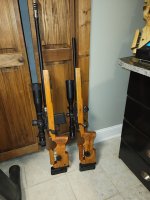So, new year, new project. Since I had pretty good success with the cherry wood stocks, I thought I would try my hand with a new material. Phenolic (linen micarta). Yes, I'm copying Foundations Stocks. Just want to get that out of the way, I'm definitely copying their stock. This is for personal use, I have no intention of selling any of this. It's for my own personal gratification in the process of making it. I love making stuff like this. I love my previous stocks. They have held up very well over the past year and I have very few complaints about them. I did make some design changes, for example, the cheek risers were too thick. This caused me to "tilt" my head to the side (neck strain) to align with the scope. So I reshaped the shooters side of the riser so that it is relieved allowing my neck to remain straight when I'm behind the rifle. I also realize I needed a thumb rest "area" on the wrist of the stock, so that is now incorporated into the design. Also, my method of CNC'ing the whole thing will be changed from a four sided operation from a solid stock blank to a two sided operation creating two halves that will be bonded/epoxied together with guide pins once the sides are cut from the blanks. This allows for a "lower to the CNC bed" operation and I won't have to raise my CNC to deal with the top and bottom jobs of a four sided operation.
But on to my actual question I'm hoping some of the smart people out here can help me understand. It appears that there are many materials (fabrics in my case) I can use for this project. Canvas, Linen and other permeable fabrics that would allow the resin to saturate easily. I was in search of those fabrics I might be able to use so that I can go on a shopping spree and source those fabrics when I discovered the site:
http://sterlingplasticsinc.com/materials/le-phenolic-linen-base-phenolic-resin/
I was amazed to see that the properties of paper were nearly equivalent to canvas and linen with regard to tensil, compression and shear. For a personal project like this (since I'm not selling it to anyone), paper is cheap, abundant and comes in many cool colors like khaki, brown, green, black and maybe some OD 3 or OD 7. I don't plan on painting this if I can use materials that give me the color(s) I like.
Does anyone out there have any experience with these three materials and have personal experience with the pros/cons of each as it might apply to such a project? (canvas, linen, paper)
Hope this post is interesting to someone.



